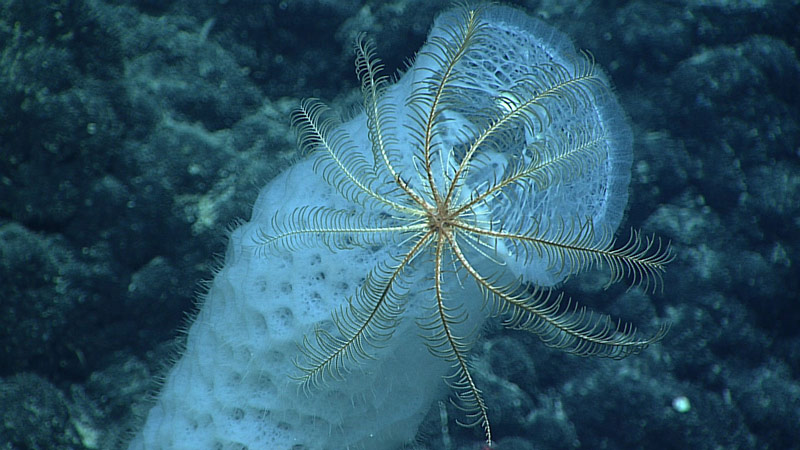
Crinoid perched on a glass sponge. Image courtesy of the NOAA Office of Ocean Exploration and Research, Deepwater Wonders of Wake. Download larger version (jpg, 827 KB).

Crinoid perched on a glass sponge. Image courtesy of the NOAA Office of Ocean Exploration and Research, Deepwater Wonders of Wake. Download larger version (jpg, 827 KB).
Dive 2: Sampson Seamount: Coral Forest
On August 2, 2016, we conducted the second remotely operated vehicle (ROV) dive of the expedition and the first dive inside the Wake Atoll Unit of the Pacifc Remote Islands Marine National Monument. During the dive, scientists found this large forest of coral. Video courtesy of the NOAA Office of Ocean Exploration and Research, Deepwater Wonders of Wake. Download larger version (mp4, 73.6 MB).
We conducted our second remotely operated vehicle (ROV) dive today. It was our first dive inside the Wake Island Unit of the Pacifc Remote Islands Marine National Monument. Just after the ROV was launched, the pilots noticed a problem with the ROV hydraulic system, so we had to recover the vehicle to make a quick repair. We redeployed the ROV a couple of hours later. The ROV reached the bottom at a depth near 2,240 meters. This location represents the southwest side of Sampson Seamount (unofficial name by Smoot, 1991). Given its depth and morphology, we expect that this seamount is a Cretaceous guyot. The dive location focuses on one of the volcanic rift zones that emanate from the central guyot platform. Along the entire ridge, we observed layered rock coated in manganese (Mn) crust.
As the ROV ascended, the terrain remained steep with massive Mn coating and very rare loose pieces of rock (one was sampled near the beginning of the dive; a volcaniclastic sedimentary rock with Mn crust). The steeper section during the first half of the dive was dominated by small primnoid octocorals, likely in the genus Narella. Interspersed between these corals were a large number of black corals. Glass sponges were also common. In the latter half of the dive where the terrain leveled out, we encountered a modest but dense stand of large bamboo corals concentrated along a rise and prominent boulder on top. Of particular interest was the observation of a rare seastar (Pythonaster sp.) on a sponge. We recovered the ROV later than usual to make up some of the time we lost with the hydraulic problem. Once the ROV was on deck, we started mapping our way to the next dive site.